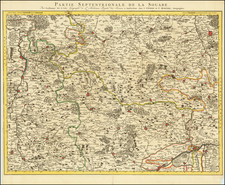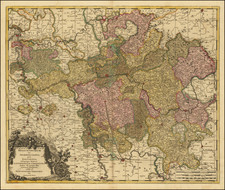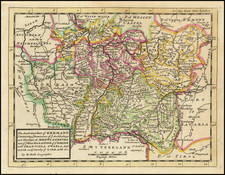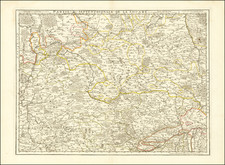This 15th-century woodblock bird's-eye view of Munich, created by Hartmann Schedel for his famed Nuremberg Chronicle, constitutes an extraordinary visual representation of the city, elegantly rendered for the book's first Latin edition of 1493.
This particular view of Munich (Monacum) stands as an exemplary artifact from the early days of European printing and urban cartography. Hartmann Schedel, a German physician, humanist, and historian, utilized woodblock printing to create his Nuremberg Chronicle (Liber Chronicarum), one of the most extensively illustrated works of the incunabula period. The inclusion of Munich in his chronicle attests to the city's prominence and significance in late medieval Germany.
The bird's-eye perspective employed by Schedel offers an intricate and informative view of Munich, capturing its urban layout, architectural features, fortifications, and surrounding landscape. This perspective, innovative for its time, presents an imaginative yet structured visual insight into the city, reflecting both artistic creativity and an emerging understanding of urban geography. It showcases the burgeoning artistic and technical skills of the period, as woodblock printing was still a relatively new technology in Europe.
The Chroncile's role in disseminating geographical and historical knowledge, not only in Germany but throughout educated Europe, underscores the cultural significance of the book. Its synthesis of text and image exemplifies the Renaissance's interdisciplinary approach, where art, history, and geography coalesced into a unified scholarly pursuit.
Hartmann Schedel (1440-1514) was a physician, book collector, and writer whose most famous work, the Liber Chronicarum (Nuremberg Chronicle), included some of the first printed views of many cities in Europe and across the world.
Schedel was born and died in Nuremberg, but he also traveled for his education. From 1456 to 1463 he lived in Leipzig, where he attended the University of Leipzig and earned his MA. From there he went to Padua, where he earned a Doctor of Medicine in 1466. After university, he worked for a time in Nördlingen and then returned to Nuremberg. In 1482 he was elected a member of the Great Council of Nuremberg.
The Chronicle was published in 1493. Besides this major work, one of Schedel’s most enduring legacies is his magnificent manuscript and printed book collection, one of the largest of the fifteenth century. In 1552, Schedel's grandson, Melchior Schedel, sold about 370 manuscripts and 600 printed works from Hartmann Schedel's library to Johann Jakob Fugger. Fugger later sold his library to Duke Albert V of Bavaria in 1571. This library is now mostly preserved in the Bayerische Staasbibliothek in Munich.
Among the surviving portions of Schedel's library are the records for the publication of the Chronicle, including Schedel's contract with Anton Koberger for the publication of the work and the financing of the work by Sebald Schreyer and Sebastian Kammermeister, as well as the contracts with Wohlgemut and Pleydenwurff for the original artworks and engravings. The collection also includes original manuscript copies of the work in Latin and German.









![Palatinatus Bavariae Descriptio . . . [with] Wirtenbergensis Ducatus...](https://storage.googleapis.com/raremaps/img/small/65838.jpg)



![[Brixen, Italy and Lauingen, German] Brixia Tyrolis [and] Laubinga Sveviae](https://storage.googleapis.com/raremaps/img/small/76740.jpg)
